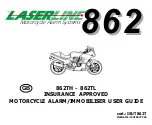
SafEye
™
™
Series 200 IR Gas Detector - User’s and Maintenance Manual
SPETCREX INC.
Doc. No. TM792100, Rev. B, Oct..1997
- 4 -
The calibration settings are designed for use in various applications:
Gas 1
-
Is pure methane and is for use in methane storage and piping
applications
Gas 2
-
Universal oil and gas production mixture to be used in all cases where
methane concentration in the mixture does not exceed 98%. It can also
be used for pure Ethane applications.
Gas 3
-
Is pure propane and is good for propane/butane detection including LPG
etc.
Gas 4
-
Is 99% methane and 1% propane and is for use in detecting methane
mixture with heavier gases where the methane component can vary
between 100% to 95%. It is also good for protecting areas where a
leak can be either pure methane or pure propane.
The four internal gas calibrations cover most of the flammable gas detection
applications. Actual selections should be made by the user in consultation with
experts to provide for safety requirements. However, for special cases where none of
the four calibrations are O.K., Spectronix, through local agents can advise how to
calibrate a SafEye detector to any specific gas.
1. 5. Description
The system comprises two main units; the Flash Source and the Detector. The SafEye
system detects gases over an open path transmitted from the Flash Source to the
Detector.
1. 5. 1.
Flash Source Unit (Figures 1-1,1-2)
The Flash Source unit emits IR radiation pulses, in a collimated beam (for maximum
intensity) to the detector unit. The source is available in three different types as
follows:
a. Reflector type, model OPSFI0x.
b. 65
φ
lens type, model OPSFI1x.
c. 80
φ
lens type, model OPSFI2x.
Refer to Table 1-1 for selection of the suitable Flash Source for the Detector.
1. 5. 2.
Detector Unit (Figure 3-1)
The detector's sensors receive the transmitted pulsed radiation signals from the Flash
Source. The signals are then amplified and fed into an analog to digital signal
converter to be processed by the internal microprocessor.
When the signals drop below a prescribed level, the internal microprocessor will
compensate for them. This will allow the signal to be maintained even in severe
weather conditions. The data is sent to the output interface section. The signals can be
sent to a standard control panel or to a central computer.










































